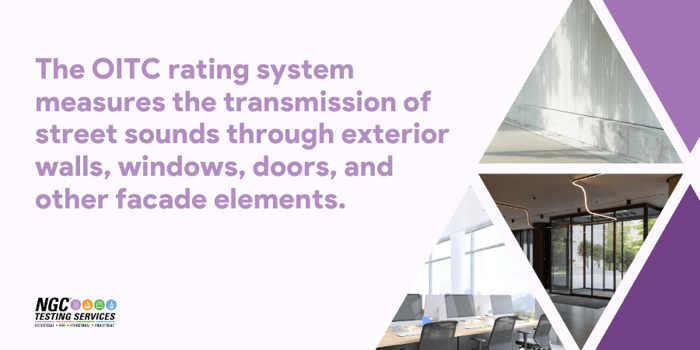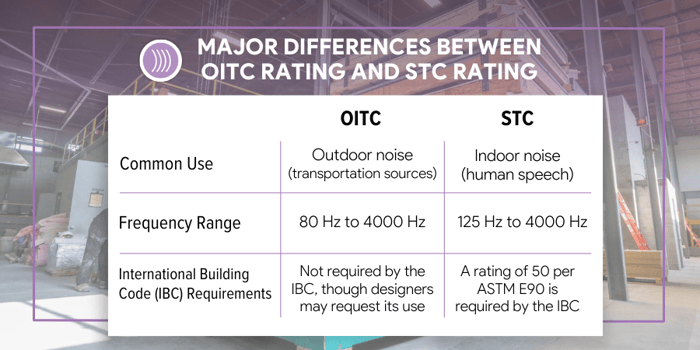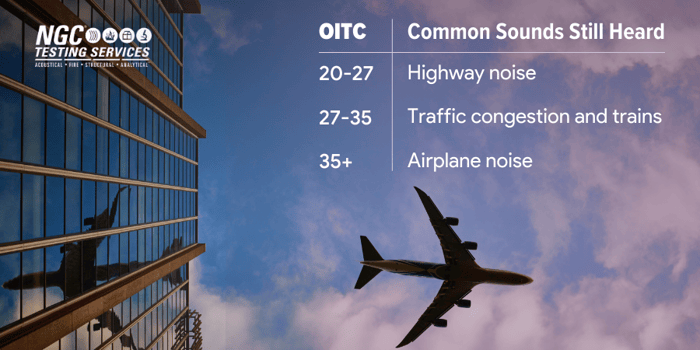Acoustical Testing
Understanding the Outdoor-Indoor Transmission Class (OITC) Rating System
If you’ve met all the building code requirements for sound transmission, but the occupant or user is still complaining about the noise from traffic or the neighbor’s subwoofer, you might have overlooked the outdoor-indoor transmission class (OITC) ratings.
This rating is relatively new, developed in 1990, and offers insight into the transmission of low-frequency noise from outside a building to the inside. It’s used to make decisions on building materials based on the building’s location and the importance of sound reduction.

What Is OITC Rating?
The OITC rating system measures the transmission of street sounds (such as car horns, sirens, construction, and low-flying airplanes) through exterior walls, windows, doors, and other facade elements. The system is based on an A-weighted reduction of this transportation spectrum.
This rating is especially important for structures in close proximity to an airport, train tracks, or a busy street. It is also helpful for occupants or businesses using a powerful subwoofer and wanting to contain the noise or offer soundproofing of their space.
The OITC rating will help ensure appropriate sound reduction materials are selected.
OITC Rating vs STC Rating
Sound transmission class (STC) ratings and OITC ratings both rate the effectiveness of an assembly to attenuate airborne sound. The ASTM E90 standard is used for measuring both, and the same types of products are rated using the same numerical rating scale.
However, the STC rating has been used much longer and is more widely recognized as the standard rating system.
Here’s a look at the differences between OITC ratings and STC ratings so you can decide if one or the other — or both — should be used for a project.

OITC Sound Rating Tests
The most common, and effective, way to determine sound transmission loss is through testing at an independent, fully-accredited facility.
Testing According to ASTM E90
ASTM International has established a standard for measuring the airborne sound transmission loss of building partitions and elements (ASTM E90). The results of this test are used to calculate both OITC and STC ratings.
Using either partition sound transmission loss chambers or floor-to-ceiling chambers, an acoustical testing consultant will analyze the attenuation, insulation, or absorption of a material or system at 16 frequencies to assess how well it may perform when installed in the field.
Acoustical tests measure based on the frequency range of 80 Hertz to 5000 Hertz, which is the primary frequency range of human hearing. The results are plotted on a sound pressure graph, allowing the laboratory to arrive at a single-number rating by fitting the measured data to the ASTM standard rating contour.
OITC Standard Classification
Exterior transportation noise tends to have a lower frequency than interior noise (such as voices), so the OITC rating system emphasizes low-frequency sounds in its calculations.
The difference between this transportation spectrum and the transmission loss data measured in ASTM E90 STC tests is used to calculate OITC ratings as per ASTM E1332.
ASTM E1332 provides methods for calculating single-number OITC ratings, which evaluate low-frequency exterior airborne sound attenuation (such as car horns, sirens, construction, and low-flying airplanes) provided by exterior walls, windows, doors, or other facade elements.
On the other hand, to calculate STC ratings, you’ll need to adhere to the ASTM E413 classification.
How to Read an OITC Rating Chart
An outdoor-indoor transmission class rating chart is used to understand the decibel scale and its relation to OITC ratings. A higher sound transmission class rating indicates more effective sound insulation than a lower rating. Most of the time, an assembly’s OITC rating is lower than an STC rating.
What Is a Good OITC Rating for Windows?
Windows are typically the weakest part of a building assembly when it comes to acoustics, which is why you’d want to know the OITC rating. A good OITC window rating is 30+ and usually comes with thicker glass (½” or more) and added glazing for additional sound reduction.
Here’s a look at what you be able to hear at each OITC window rating:

Including OITC Ratings in Your Next Project
While not yet required in most building codes, OITC ratings can provide valuable information for designers, especially when a building is located in close proximity to busy streets or airports.

To be sure you’re getting an accurate calculation, choose an accredited testing facility, such as NGC Testing Services. NGC Testing Services is ISO/IEC 17025 compliant, NVLAP accredited, and tests according to ULC, NFPA, UL, FM, ICC, ISO, AAMA, ANSI, and SAE standards.
In addition to acoustical evaluations, NGC Testing Services also has the capability to conduct tests on these types of exterior products and systems for fire performance, wind load, water penetration, and air infiltration.
Contact our team to learn more about our acoustical testing and other services.
This post was originally published in December 2020 by Bob Menchetti and was updated and republished in October 2023.
Search blog articles
Browse by topic
Subscribe for updates
GET IN TOUCH
Contact Us
NGC Testing Services features one of North America's most comprehensive and unique fully accredited testing facilities. Contact us today to visit our 50,000-plus-square-foot facility located in Buffalo, New York.

